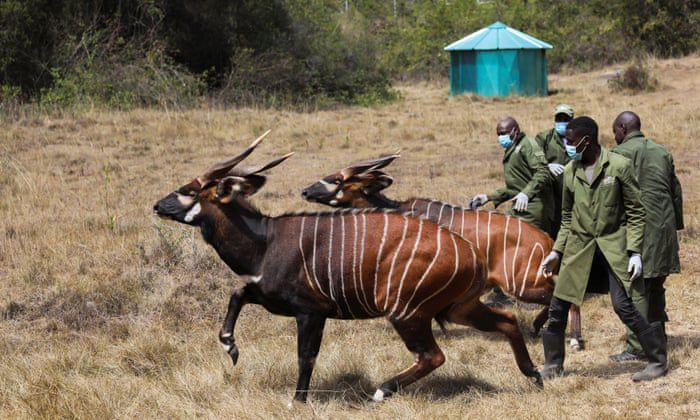Kenya Welcomes Back Its Lost Mountain Bongos

As the cargo plane touched down in Kenya late Sunday night, a sense of homecoming filled the air. On board were not just animals, but living symbols of resilience and national pride—17 mountain bongos returning to the land of their ancestors after more than half a century abroad.
For local conservationist Joseph Mwenda, watching the animals step onto Kenyan soil was deeply personal. “It’s like welcoming back family,” he said, eyes welling with emotion. “These bongos are part of our heritage, and seeing them return gives us hope for the future of our wildlife.”
Once numbering in the hundreds, Kenya’s mountain bongos were taken during the country’s struggle for independence in the 1960s, leaving behind a gaping hole in the nation’s natural heritage. Now, their return represents more than conservation—it’s a healing of historical wounds and a reclaiming of what was lost.
The 17 rare animals, brought from Florida, arrived in Kenya around 9:10 p.m. and were quickly transported to Meru for quarantine. This temporary measure will ensure their health before they are gradually reintroduced into their native ecosystem.
Wildlife experts note that mountain bongos are unique to Kenya, and their survival abroad has always been a reminder of the country’s colonial past. Their return is more than a scientific achievement; it’s an emotional victory for communities who have long considered these creatures part of their cultural and environmental identity.
Kenya currently has fewer than 100 mountain bongos remaining in the wild. But the return of these animals brings renewed optimism. Once integrated into the ecosystem, the new arrivals are expected to breed and potentially produce a lineage that could save the species from extinction.
Tourism Cabinet Secretary Rebecca Miano expressed her hopes for the future: “Our goal is to increase the population to more than 700 by 2050. This is not just about numbers; it’s about restoring balance to our environment and reconnecting with our natural heritage.”
This repatriation follows years of international negotiations and diplomatic efforts. The first return of mountain bongos occurred in 2004, marking the beginning of Kenya’s long journey toward restoring its wildlife. Now, with another batch expected from Europe in the coming months, the country is doubling down on its commitment to conservation.
Dr. Erastus Kanga, Director General of the Kenya Wildlife Service, emphasized the broader impact of the effort. “This is about more than just saving a species. It’s about enhancing tourism, creating jobs, and empowering local communities. Every bongo that thrives here strengthens Kenya’s position as a leader in global conservation.”
For mountain enthusiasts and nature lovers, the return of the bongos signals a brighter future. Once elusive and rare, these animals may soon become a familiar sight in Kenya’s lush forests, reigniting a sense of wonder among locals and tourists alike.
“Each sighting will remind us of what’s possible when nations come together to do what’s right,” Miano said. “Together, we are building a sustainable future for both our wildlife and our communities.”







Comments (0)
No comments yet. Be the first to comment!